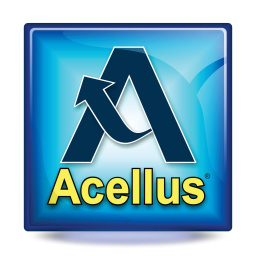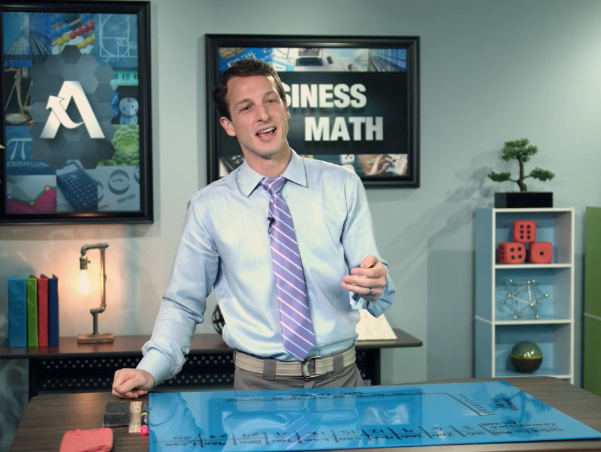Business Math

Course Features
Course Details
Course Overview
In the Acellus Business Math course, students gain knowledge of the specific applications of mathematics in the business world. They begin with the mathematical aspects of personal business, and move into banking, real estate, vehicles, and insurance. They become familiar with manufacturing and employment costs, discounts, maintenance costs, professional services, marketing costs, and business accounting.
Course topics include:
- Wages and Salaries
- Taxes, Insurance, and Budgeting
- Banking
- Stocks and Bonds
- Credit
- Mortgages and Real Estate
- Vehicle Costs
- Health Insurance
- Profits and Pricing
- Manufacturing – Break-Even Analysis and Quality Control
- Employees – Salary, Benefits and Insurance
- Profits, Sticker Price, and Discounts
- Inventory Considerations and Business Expenses
- Sales Potential, Market Share and Sales Projections
- Balance Sheet and Analysis
- Taxes, Borrowing, and Inflation
Sample Lesson - Commission
 This course was developed by the International Academy of Science.
Learn More
This course was developed by the International Academy of Science.
Learn More
Scope and Sequence
Unit 1 - Wages Students begin the Business Math course learning about different ways that wages are handled. They study hourly wages, overtime pay, weekly time cards, and piecework pay, as well as salary and commission. Unit 2 - Taxes and Budgeting In this unit students investigate various taxes, including state and federal income tax, social security and medicare tax, and sales tax. They consider the concepts that must be taken into account to create a personal budget, such as health insurance premiums, gross pay versus take-home pay, and average monthly expenditures. They learn to prepare a budget sheet and to do a budget analysis. They also study unit pricing, coupons, rebates, and discounts. Unit 3 - Banking Next students investigate banking, beginning with deposits and payments, and continuing with learning to reconcile a bank statement. They consider banking fees. They compare checking and savings accounts. They explore simple and compound interest, and they compare traditional and Roth IRA's. Unit 4 - Stocks and Bonds Students consider certificates of deposit (CD's) and learn what an effective annual yield is. They study stocks and their dividends, selling stocks, and bonds. Unit 5 - Credit In this unit students explore credit card statements. They learn about interest expense from credit cards and about average daily balance interest calculation. They investigate single-payment loans, installment loans with down payments, installment loans with monthly payments and finance charges, and prepayment of loans. They learn to calculate interest on an installment loan. Unit 6 - Mortgages and Real Estate Students investigate mortgage loans. They consider monthly payments and total interest, as well as closing costs. They explore the principal and interest on monthly mortgage payments. They study homeowner's insurance and its premiums, as well as utilities and maintenance costs. Unit 7 - Vehicle Costs Students learn about comparing and figuring the cost of a vehicle including, buying a new or used vehicle, insurance, and operating and maintenance fees. Unit 8 - Health Insurance Students get a look at the mathematics involved in health insurance. They learn how premiums work and how to compare costs of different health insurance plans. Students explore term life, dental, and disability insurance. Following this unit students are presented with the Mid-Term Review and Exam. Unit 9 - Profits and Pricing In this unit students learn about gross and net profit, how they are calculated and the difference between the two. Students study how to determine sticker price with cost percentage, markup percentage, and how fixed and variable costs effect sticker price. Students also study discounts from a math perspective. Unit 10 - Manufacturing This unit focuses on the math involved in manufacturing including break-even analysis and units produced over time. Students learn from real life examples about quality control in manufacturing, percent utilization, and how to figure in materials and shipping costs. Unit 11 - Employees In this unit students experience how to figure costs for recruiting new employees, salary adjustments, and employee benefits. Other topics include disability insurance, worker's compensation, unemployment insurance, and travel expenses. Students also learn about the value of employee training and associated costs. Unit 12 - Inventory Students examine requirements for space and the costs associated with keeping an inventory. They learn about valuing inventory and inventory depreciation, and how to factor in the cost of transportation when assessing inventory costs. Unit 13 - Discounts Students learn about different types of discounts and their uses. They are taught about trade discounts, chain discounts, cash discounts and net term and end-of-month (EOM) dating. Unit 14 - Building and Operating Expenses Students consider other expenses often required for a business including building rental, maintenance and improvement, equipment rental, utilities, and professional services. Unit 15 - Sales Projections and Advertising Costs Students learn about opinion surveys and use their math skills to figure sales potential, market share, and sales projections. Students also learn how to calculate advertising costs for various media including newspaper, TV, online, and mobile. Unit 16 - Business Expenses and Depreciation Students learn about the payroll register and calculating wages and withholdings. Lessons in this unit include business expenses, apportioning expenses, depreciation, and the purpose of a modified accelerated cost recovery system. Unit 17 - Balance Sheet and Analysis This unit teaches students about assets, liabilities, and equity and how the balance sheet works. Students also learn about cost of goods sold, the income statement, vertical analysis, and longitudinal analysis. Unit 18 - Taxes, Borrowing, and Inflation In the final lessons students integrate their math skills to figure corporate income taxes, stocks and bonds, borrowing, treasury bills and commercial paper, expansion expenses, and inflation. Students are also introduced to the consumer price index. Following this unit students are presented with the Final Review and Exam.
This course does not have any sections.






